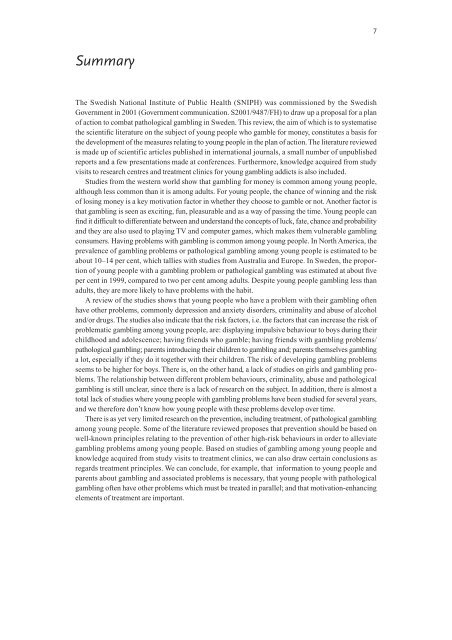Spel om pengar bland unga, 750 kB - Statens folkhälsoinstitut
Spel om pengar bland unga, 750 kB - Statens folkhälsoinstitut
Spel om pengar bland unga, 750 kB - Statens folkhälsoinstitut
You also want an ePaper? Increase the reach of your titles
YUMPU automatically turns print PDFs into web optimized ePapers that Google loves.
Summary<br />
The Swedish National Institute of Public Health (SNIPH) was c<strong>om</strong>missioned by the Swedish<br />
Government in 2001 (Government c<strong>om</strong>munication. S2001/9487/FH) to draw up a proposal for a plan<br />
of action to c<strong>om</strong>bat pathological gambling in Sweden. This review, the aim of which is to systematise<br />
the scientific literature on the subject of young people who gamble for money, constitutes a basis for<br />
the development of the measures relating to young people in the plan of action. The literature reviewed<br />
is made up of scientific articles published in international journals, a small number of unpublished<br />
reports and a few presentations made at conferences. Furthermore, knowledge acquired fr<strong>om</strong> study<br />
visits to research centres and treatment clinics for young gambling addicts is also included.<br />
Studies fr<strong>om</strong> the western world show that gambling for money is c<strong>om</strong>mon among young people,<br />
although less c<strong>om</strong>mon than it is among adults. For young people, the chance of winning and the risk<br />
of losing money is a key motivation factor in whether they choose to gamble or not. Another factor is<br />
that gambling is seen as exciting, fun, pleasurable and as a way of passing the time. Young people can<br />
find it difficult to differentiate between and understand the concepts of luck, fate, chance and probability<br />
and they are also used to playing TV and c<strong>om</strong>puter games, which makes them vulnerable gambling<br />
consumers. Having problems with gambling is c<strong>om</strong>mon among young people. In North America, the<br />
prevalence of gambling problems or pathological gambling among young people is estimated to be<br />
about 10–14 per cent, which tallies with studies fr<strong>om</strong> Australia and Europe. In Sweden, the proportion<br />
of young people with a gambling problem or pathological gambling was estimated at about five<br />
per cent in 1999, c<strong>om</strong>pared to two per cent among adults. Despite young people gambling less than<br />
adults, they are more likely to have problems with the habit.<br />
A review of the studies shows that young people who have a problem with their gambling often<br />
have other problems, c<strong>om</strong>monly depression and anxiety disorders, criminality and abuse of alcohol<br />
and/or drugs. The studies also indicate that the risk factors, i.e. the factors that can increase the risk of<br />
problematic gambling among young people, are: displaying impulsive behaviour to boys during their<br />
childhood and adolescence; having friends who gamble; having friends with gambling problems/<br />
pathological gambling; parents introducing their children to gambling and; parents themselves gambling<br />
a lot, especially if they do it together with their children. The risk of developing gambling problems<br />
seems to be higher for boys. There is, on the other hand, a lack of studies on girls and gambling problems.<br />
The relationship between different problem behaviours, criminality, abuse and pathological<br />
gambling is still unclear, since there is a lack of research on the subject. In addition, there is almost a<br />
total lack of studies where young people with gambling problems have been studied for several years,<br />
and we therefore don’t know how young people with these problems develop over time.<br />
There is as yet very limited research on the prevention, including treatment, of pathological gambling<br />
among young people. S<strong>om</strong>e of the literature reviewed proposes that prevention should be based on<br />
well-known principles relating to the prevention of other high-risk behaviours in order to alleviate<br />
gambling problems among young people. Based on studies of gambling among young people and<br />
knowledge acquired fr<strong>om</strong> study visits to treatment clinics, we can also draw certain conclusions as<br />
regards treatment principles. We can conclude, for example, that information to young people and<br />
parents about gambling and associated problems is necessary, that young people with pathological<br />
gambling often have other problems which must be treated in parallel; and that motivation-enhancing<br />
elements of treatment are important.<br />
7

















